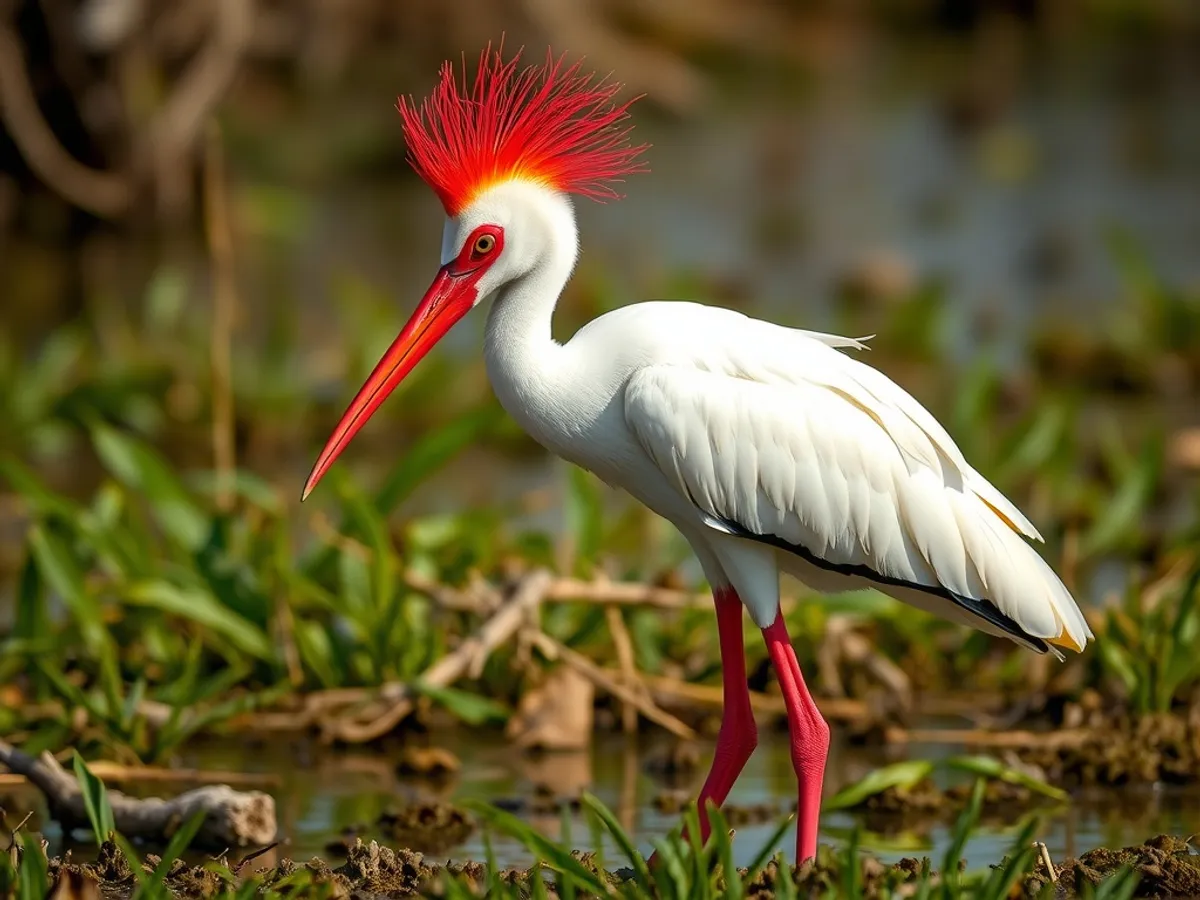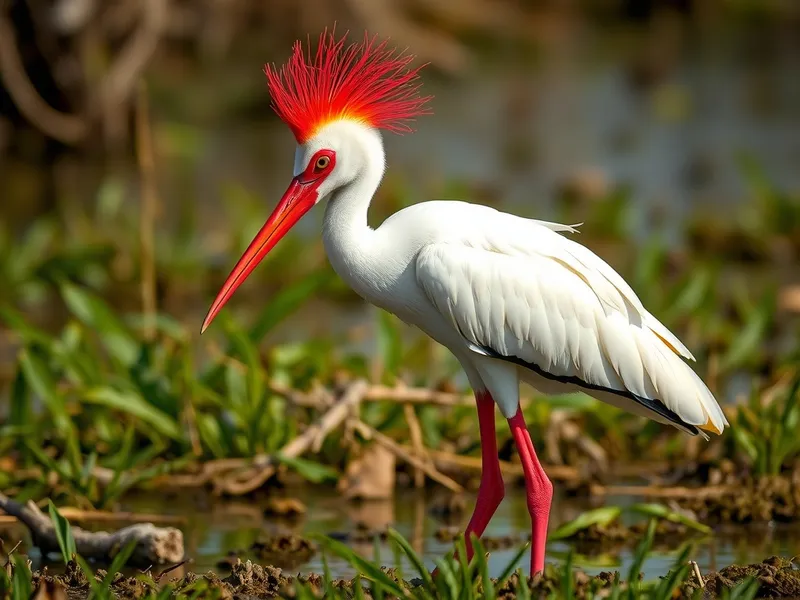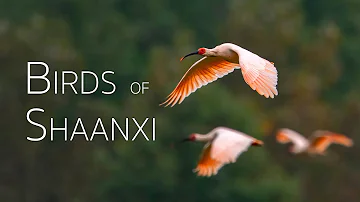
Crested Ibis
Nipponia nippon

Meet the Crested Ibis
The Crested Ibis is a striking, medium-sized wading bird recognized by its pure white plumage, long down-curved bill, and elegant, wispy crest of white feathers on its head. During breeding season, its face and legs turn a vivid red, adding to its distinctive appearance. Once widespread across East Asia, it is now critically endangered, with wild populations surviving almost exclusively in central China due to habitat loss and overhunting. Crested Ibises prefer wetland habitats, feeding in rice paddies, shallow rivers, and marshes, where they use their sensitive bills to probe for prey. Intensive conservation efforts have helped stabilize and slowly increase their numbers, but they remain one of the world’s rarest birds.
Classification
Bird
Habitat
Wetlands, marshes, rice paddies, and riverbanks
Diet
Carnivore
Lifespan
15-20 years
Conservation
Endangered
Weight
1.8–2.5 kg
📖Fascinating Facts
Elegant Crest
The Crested Ibis is named for its beautiful crest of white feathers, which it raises during displays and social interactions.
Rice Paddy Resident
Crested Ibises are often found foraging in rice paddies, where their presence helps control pests and balance the ecosystem.
Conservation Success
Thanks to intensive protection and breeding programs, the Crested Ibis population has increased from just seven individuals in the 1980s to several hundred today.
📋Detailed Description
The Crested Ibis (Nipponia nippon) is a medium-sized wading bird, measuring 56–84 cm (22–33 in) in length, with a wingspan of 120–140 cm (47–55 in) and a weight ranging from 1.8 to 2.5 kg. Its most distinctive features are its pure white plumage, which may take on a pinkish hue during the breeding season due to a secretion from the uropygial gland, and its long, slender, decurved black bill tipped with red. The bird's elegant crest of elongated white plumes extends from the nape, and during the breeding season, the bare skin on its face and legs turns a vivid crimson, enhancing its striking appearance. The eyes are reddish, and the legs are long and adapted for wading in shallow water. Crested Ibises are diurnal, foraging mainly at dawn and dusk, and are highly social outside the breeding season, often forming loose flocks. Their vocalizations are distinctive, consisting of a series of croaking or trumpeting calls, especially during courtship or when alarmed. The species is monotypic within its genus, with no recognized subspecies. Historically, their range extended across eastern Russia, Korea, Japan, and China, but today wild populations are confined to Shaanxi Province, China, following extensive reintroduction efforts. They prefer open wetlands, rice paddies, and riverbanks, where they use their sensitive bills to probe for aquatic invertebrates, small fish, frogs, and insects. The Crested Ibis is an indicator species for healthy wetland ecosystems and is highly sensitive to environmental changes.
💡 Did you know?
By the 1980s, only seven wild Crested Ibises remained in the world, all found in a remote Chinese village, making their recovery one of the most remarkable bird conservation stories.
🔬Research & Sources
Wikipedia Summary
The crested ibis, also known as the Japanese crested ibis, or Asian crested ibis, is a species of ibis, native to eastern Asia. It is the only member of the genus Nipponia. In Japan, where it has special cultural significance, the name is トキ toki.
Last Modified: 6/6/2025
🎭Behavior & Social Structure
Crested Ibises exhibit crepuscular foraging behavior, being most active during early morning and late afternoon. They feed by slow, deliberate walking in shallow water or soft mud, using their tactile bills to probe for prey such as earthworms, aquatic insects, crustaceans, small amphibians, and occasionally small fish. Socially, they are gregarious outside the breeding season, roosting communally in tall trees near water. During the breeding season, pairs become territorial and defend nesting sites vigorously. Their daily routine includes preening, bathing, and sunning, often observed spreading their wings to dry. Communication involves a variety of calls, especially during courtship and when threatened. They exhibit strong site fidelity, often returning to the same nesting and foraging areas year after year.
👶Reproduction & Life Cycle
Crested Ibises are monogamous, forming long-term pair bonds. The breeding season typically spans from March to June. Courtship involves mutual preening, bill crossing, and ritualized displays. Nests are constructed in tall trees, often at the edge of forests or near wetlands, using sticks and lined with softer materials. The female usually lays 2–5 pale blue-green eggs, which are incubated by both parents for 28–30 days. Both parents share in feeding and brooding the chicks, which fledge at around 40–45 days old. Juveniles remain dependent on adults for several weeks post-fledging. Breeding success is closely tied to habitat quality and food availability, with high nest predation and human disturbance posing significant risks.
🛡️Adaptations & Survival
The Crested Ibis possesses several adaptations for wetland foraging, including long legs for wading and a highly sensitive, decurved bill capable of detecting prey by touch in murky water or mud. Their white plumage may provide camouflage against the sky when viewed from below by aquatic prey or predators. The seasonal reddening of facial skin and legs is thought to play a role in mate selection and social signaling. Their communal roosting behavior enhances predator detection and thermoregulation. Physiologically, they are adapted to tolerate a range of temperatures, from cold winters to hot, humid summers typical of their native range.
📚Research Sources
🎨Cultural Significance
In Japan, the Crested Ibis (トキ, toki) is a symbol of purity, longevity, and good fortune, frequently appearing in art, poetry, and folklore. It is designated as a Special Natural Monument and was historically revered for its elegance and grace. The bird's near-extinction and subsequent recovery have made it an emblem of conservation and environmental awareness in East Asia. In China, it is a flagship species for wetland conservation and is celebrated in local festivals and educational campaigns. The Crested Ibis is also featured on currency, stamps, and as a mascot for environmental initiatives.
🔬Recent Research & Discoveries
Recent genetic studies have focused on assessing the genetic diversity of both wild and captive populations, revealing low heterozygosity and highlighting the need for careful management to avoid inbreeding. Satellite tracking and banding programs have provided insights into the species' movement ecology, habitat use, and dispersal patterns. Research on foraging ecology has informed rice paddy management practices to enhance food availability. Ongoing studies are examining the impacts of climate change and land-use shifts on breeding success and population viability. The success of reintroduction programs in Japan and China is a model for avian conservation, with international collaboration continuing to monitor and support population recovery.
🎥Wildlife Videos

Crested Ibis In China (Bird Documentary Film)
Chinese efforts to bring the crested ibises back to the wilderness. Other names for this species of birds: Nipponia nippon, Toki ...
Mother Nature TV

Cloudy Qinling Series Ep. 5: 'Noah's Ark' for crested ibis
Since the early 20th century, the rapid industrialization of the world, though it brought numerous benefits to people, has ...
CGTN Nature

CGTN Nature: Qinling Mountains Series | Episode 10: Warmth of Love
For the crested ibis couple, the utmost task now is to enlarge the family. Hatching eggs is a lengthy process, and the parents ...
CGTN Nature

CGTN Nature: Qinling Mountains Series | Episode 8: Crested Ibis
Endemic to eastern Asia, the crested ibis at one time was widespread in China, Japan and Korea. But due to habitat loss, the ...
CGTN Nature

How China Saved the Asian Crested Ibis | Kyle Obermann
The Asian Crested ibis is one of the world's most rare birds. And if it were not for a small group of conservationists in China's ...
The China Current

Shaanxi, The Home of the Crested Ibis | Birding in China
Video taken in October 2020 in Yangxian County, Shaanxi Province, China. 16 species of birds appear in the video. Crested Ibis ...
SuBirds Nature Tours
🌍Habitat Information
The Crested Ibis typically inhabits Wetlands, marshes, rice paddies, and riverbanks environments. Crested Ibiss have adapted to their environments with specialized features and behaviors.
Primary Habitat:
Wetlands, marshes, rice paddies, and riverbanks
More detailed habitat information will be available soon.
🛡️Conservation Status
The Crested Ibis is currently classified as Endangered. Conservation efforts are crucial for preserving this species for future generations.
Common Threats:
- 🏠Habitat loss and fragmentation
- 🌡️Climate change impacts
- 🎯Hunting and poaching
- 🏭Human-wildlife conflict
⚠️Threats & Conservation Challenges
Major threats to the Crested Ibis include habitat loss due to wetland drainage, agricultural intensification, pesticide use, and deforestation. Historically, overhunting for feathers and food contributed to their decline. Modern challenges include genetic bottlenecking due to the small founding population, disease susceptibility, and inbreeding depression. Human disturbance during the breeding season can lead to nest abandonment. Conservation efforts have focused on habitat restoration, captive breeding, and reintroduction programs, particularly in China and Japan. While numbers have increased from a low of seven wild individuals in the 1980s to over 4,000 today (including captive and reintroduced birds), the species remains highly vulnerable to environmental changes and stochastic events.
🔬Scientific Classification
Scientific Name
Nipponia nippon
Classification Hierarchy
🔍 About Taxonomic Classification
Taxonomic classification is a hierarchical system used by scientists to classify and organize living organisms based on shared characteristics and evolutionary relationships.
The system moves from broad categories (Kingdom) to increasingly specific ones, with each animal's scientific name typically consisting of its Genus and species.
📝Community Notes
Share your observations and insights about the Crested Ibis with our community of wildlife enthusiasts.
Join Our Community
Sign in to share your observations and connect with fellow wildlife enthusiasts.
Sign In to ContributeNo community notes yet
Be the first to share your observations about the Crested Ibis!
Explore Crested Ibis
Select a tab above to learn more about this amazing animal.
📸Photo Gallery
No photos available for this animal yet.
🌟Discover More Wildlife
Continue your journey of discovery with more fascinating animals from our database
